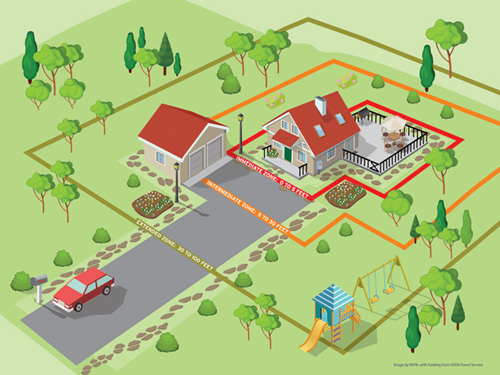Defensible Space Zones
Creating defensible space around your home is one of the best ways to reduce wildfire risk. A fire break is a cleared strip of land that slows or stops the spread of a wildfire by removing any fuel that could burn. Defensible space is crucial for slowing or stopping wildfire and even helps to protect the firefighters defending your home.

Zone 1 (0–5 ft):
This is the most important zone to take immediate action on as it is the most vulnerable to embers. Begin with the house itself, before moving onto other areas.
- Clean roofs and gutters of dead leaves, debris and pine needles that could catch embers.
- Replace or repair any loose or missing shingles or roof tiles to prevent ember penetration.
- Trim branches that hang over your roof or within 10 ft of a chimney
- Install a 1/8 metal mesh screen in eaves and attic vents to reduce ember penetration.
- Clean debris from exterior attic vents.
- Repair or replace damaged or loose window screens and any broken windows
- Screen or box-in areas below patios and decks with wire mesh to prevent debris and combustible materials from accumulating.
- Move any flammable material away from wall exteriors – mulch, flammable plants, leaves and needles, firewood piles.
- Remove anything stored underneath decks or porches.
- Remove all dead plants, grass, and weeds around your home.
Zone 2 (5–30 ft):
- Mow grass regularly to 4″ or less.
- Space trees at least 10 feet apart.
- Remove fallen leaves, pine needles, and flammable debris.
- Clear vegetation from under large stationary propane tanks.
- Create fuel breaks with driveways, walkways/paths, patios, and decks.
- Remove ladder fuels (vegetation under trees).
Zone 3 (30–100 ft):
- Thin vegetation to slow fire spread.
- Maintain clear access path for emergency responders.
- Dispose of heavy accumulations of ground litter/debris.
- Remove dead plant and tree material.
- Remove small conifers growing between mature trees.
- Remove vegetation adjacent to storage sheds or other outbuildings within this area.
- Trees 30 to 60 feet from the home should have at least 12 feet between canopy tops.*
- Trees 60 to 100 feet from the home should have at least 6 feet between the canopy tops.*

